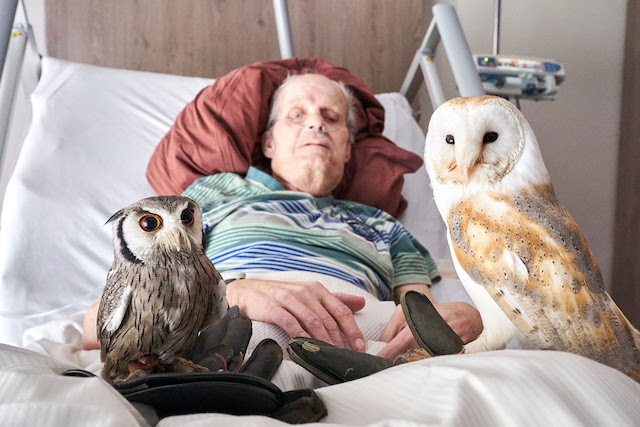By Birgit Reichert, dpa I Tuesday, June 6, 2023
BERLIN – A team of owls is comforting the terminally ill at hospices and hospitals throughout Germany. The patients are free to pet and cuddle the birds who are specially trained for the interactions.
Horst Demsky, a patient at a hospice in Germany, is no longer strong enough to get up.
Two owls gaze at him with bright orange eyes, sitting perched on a falconer’s glove on his duvet. It is strangely calming.
Demsky strokes their feathers gently. “Darling, fine,” he says quietly. After a little while, he adds, “I used to have two parrots.”
He smiles again and again as falconer Katharina Häfner introduces the birds to him. There’s barn owl Emma and white-faced owl Merlin, who have become regulars at the St. Martin hospice in Koblenz, south-western Germany.
Their presence triggers visible joy in Demsky, which is precisely the idea behind using owls as therapy pets, says Häfner. Her team “Falconers of the Heart,” based in Bisterschied, 100 kilometres south-west of Frankfurt, visits hospices and palliative care institutions for children nationwide. The animals bring comfort for the terminally ill during their last phase of life.
“We bring joy and perhaps a little happiness to the people there once again,” the 29-year-old says.
In Demsky’s case, it was successful. “It was a nice surprise,” he says of the visiting owls.
It’s already the birds’ third time here, always “a very special event,” says deputy hospice director Ingrid Ferdinand who has witnessed first-hand the enthusiasm the owls manage to arouse in those who are seriously ill.
“People always say, everything is so sad in the hospice. One of our principles is that we live the day we have as best we can. And this is such a highlight,” she says of the falconer’s visit.
In one of the hospice’s other 10 rooms, Swen Pinkatschek, who has a brain tumour, is surrounded by members of his family.
His wife, sitting at his bedside, smiles when their son Claas comes into the room with little owl Merlin and falconer Häfner in tow, who’s carrying barn owl Emma. “This is the first time owls have been so close to us,” says Tamara Pinkatschek.
Claas, who is turning 7 today, puts the owl on the bed and tells his father, “Daddy, you always have to stroke it here like this, it likes that.” Their special moment is captured with many photos.
“Owls bring a lot of peace and quiet. Owls help you become calm,” says Häfner, originally from northern Germany.
This is what sets them apart from other therapy animals such as dogs or alpacas for example, she says. When she brings in the owls, “people start talking more,” Häfner says. And the interaction also triggers lots of memories, she adds. “It opens a door in the mind,” even for patients with Alzheimer’s or dementia.
When asked, many people are suddenly able to recall their own name, even if they haven’t been able to recall it for the past five years according to the carers, Häfner says.
Another hospice resident, Jose Lay also enthusiastically awaits the birds’ visit.
He has been an “owl fan” since childhood, he says sitting on the terrace of the Koblenz hospice. “In the evenings at home, I also heard the sound of owls.”
Lay has a collection of owl figurines made of ceramic in his room. “Owls are very intelligent and very beautiful creatures,” he says. During the visit, he only has eyes for the owls, even petting a large eagle owl. “I’ve never been so close before. It’s a beautiful experience.”
“Cuddling, stroking and kissing – it’s all possible,” says falconer Häfner of the therapy owls. “They are used to that.”
The birds are hand-raised from an early age, she says. “We get them when they are 10 to 14 days old. They live with us in the kitchen and lie on the sofa in the living room with us in the evening and they get lots and lots of love and affection.” Also, she says, the owls know that once they’re sitting on the glove, “that’s working time.”
There are 45 birds in all at the falconry in Bisterschied, most of them owls.
Häfner joined the Falconers of the Heart six years ago, but her husband Achim Häfner has been working with the creatures for more than 20 years.
Their team also visits old people’s homes, schools, kindergartens and institutions for the disabled, which pay for their visits. Many of their bookings come from institutions in Berlin, says Katharina Häfner. “We go there twice a year for two to three weeks at a time.”
Meanwhile the falconers visit hospices like St. Martin in Koblenz free of charge.
For Häfner, those trips are “a fulfilment and a total matter of the heart.”
“If I meet a person there whom I managed to touch deeply, then I have done it for exactly that person. Then it was the right thing to do for them,” she says.
The inpatient hospice in Koblenz, whose patients are receiving palliative care, is already planning to invite the owls back.
Caregivers and nursing staff also draw strength from experiences like that, says director Ferdinand. “It’s balm for the soul. For both sides.”

